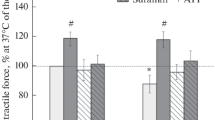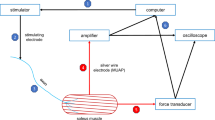Abstract
Spike recordings were obtained with preparations of group III and IV fibers from the nervus peroneus of the rat. During the recordings the muscle was stimulated by chemical substances simulating metabolic effects of static exercise: increase of [K+], enhancement of osmolality and increase of concentrations of lactic acid and inorganic phosphates. Two experimental setups were used: in series I application was performed by a perfusion of the circulatorily isolated hindleg, and in series II a single muscle of the hindleg (musculus extensor digitorum longus) was superfused by control or test solutions. Only those fiber preparations were further investigated which did not respond to pressure, tension or squeezing of the muscle. Only few fibers that were exposed to all of our stimuli responded to none of them; from the rest; about the half were selective or only preferential for one stimulus. The majority of the fibers adapted their response after 8 min while the applications still endured. A comparison of all fibers (in series II) proved that all the four stimuli elicited significant increases of activity. The greatest significant effects were found for lactic acid and potassium (in series I and II). Since the concentrations used in the test applications were characteristic for medium and heavy exercise these results support the hypothesis that metabolic muscle receptors participate in the peripheral control of circulatory and respiratory drives during static exercise.
Similar content being viewed by others
References
Alam M, Smirk FH (1938) Observation in man on a pulseaccelerating reflex from the voluntary muscles of the legs. J Physiol 92:167–177
Asmussen E, Nielssen M (1964) Experiments on nervous factors controlling respiration and circulation during muscular exercise employing blocking of the blood flow. Acta Physiol Scand 60:103–111
Baum K, Eßfeld D, Stegemann J (1987) The influence of the muscular interstitial volume on K+-induced heart rate drives in rats. Eur J Appl Physiol (in press)
Bessou P, Perl ER (1969) Response of cutaneous sensory units with unmyelinated fibers to noxious stimuli. J Neurophysiol 32:1025–1043
Clifton GL, Coggeshall RE, Vance WH, Willis WD (1976) Receptive fields of unmyelinated ventral root afferent fibers in the cat. J Physiol (Lond) 256:573–601
Coote JH, Hilton SM, Pérez-González JF (1971) The reflex nature of the pressor response to muscular exercise. J Physiol (Lond) 215:789–804
Dejours P (1962) Chemoreflexes in breathing. Physiol Rev 42:335–358
Dejours P (1967) Neurogenic factors in the control of ventilation during exercise. Circ Res 20:I146-I153
Fisher M, Nutter DO (1974) Cardiovascular reflex adjustments to static muscular contractions in the canine hindlimb. Am J Physiol 226(3):648–655
Fock S, Mense S (1976) Excitatory effects of 5-hydroxy-tryptamine, histamine and potassium ions on muscular group IV afferent units: a comparison with bradykinin. Brain Res 105:459–469
Franz DN, Iggo A (1968) Conduction failure in myelinated and non-myelinated axons at low temperatures. J Physiol 199:319–345
Franz M, Mense S (1975) Muscle receptors with group IV afferent fibers responding to application of bradykinin. Brain Res 92:369–383
Gebert G (1972) Messung der K+-und Na+-Aktivität mit Mikro-Glaselektroden im Extracellularraum des Kaninchenmuskels bei Muskelarbeit. Pflügers Arch 331:204–214
Hermansen L, Vaage O (1977) Lactate disappearance and glycogen synthesis in human muscle after maximal exercise. Am J Physiol 233:E422-E429
Hertel HC, Howald B, Mense S (1976) Responses of group IV and group III muscle afferents to thermal stimuli. Brain Res 113:201–205
Hilton SM (1977) Evidence for phosphate as a mediator of functional hyperaemia in skeletal muscles. Pflügers Arch 369:151–159
Hirche JH, Hombach V, Langohr HD, Wacker K, Busse J (1975) Lactic acid permeation rate in working gastrocnemii of dogs during metabolic alkalosis and acidosis. Pflügers Arch 356: 209–222
Hirche HJ, Schumacher E, Hagemann H (1980) Extracellular K+ concentration and K+ balance of gastrocnemius muscle of the dog during exercise. Pflügers Arch 287:231–237
Hník P, Hudlická O, Kučera J, Payne R (1969) Activation of muscle afferents by nonproprioceptive stimuli. Am J Physiol 217:1451–1457
Kalia M, Senepati JM, Paride B, Panda A (1972) Reflex increase in ventilation by muscle receptors with non-medullated fibres. J Appl Physiol 32:189–193
Kao FF (1963) An experimental study of the pathway involved in exercise hyperpnoea employing cross-circulation techniques. In: Cunningham DJC, Lloyd BB (eds) The regulation of human respiration. Blackwell, Oxford, pp 461–502
Kaufmann MP, Longhurst JC, Rybicki KJ, Wallach JH, Mitchell JH (1983) Effects of muscular contraction on impulse activity of group III and IV afferents in cats. J Appl Physiol 55:105–112
Kaufmann MP, Waldrop TG, Rybicki KJ, Ordway GA, Mitchell JH (1984) Effects of static and rhythmic twitch contractions on the discharge of group III and IV muscle afferents. Cardiovasc Res 18:663–668
Kniffki K-D, Mense S, Schmidt RF (1978) Response of group IV afferent units from skeletal muscle to stretch, contraction and chemical stimulation. Exp Brain Res 31:511–522
Kniffki KD, Mense S, Schmidt RF (1981) Muscle receptors with fine afferent fibres which may evoke circulatory reflexes. Suppl I, Circ Res 48, 6:I124-I131
Kumazawa T, Mizumura K (1977) Thin-fibre receptors responding to mechanical, chemical and thermal stimulation in the skeletal muscle of the dog. J Physiol 273:179–194
Laporte Y, Leitner LM, Pagès B (1962) Absence d'effets réflexes circulatoires des fibres afférentes du group I. Compt Rend Soc Biol 156:2130–2133
Lasser RP, Schoenfeld MR, Allen DF, Friedberg CK (1960) Relfex circulatory effects elicited by hypertonic and hypotonic solutions injected into femoral and brachial arteries of dogs. Circ Res 8:913–919
Liu RKS, Guzman F, Rodger DW, Gato K, Braun C, Dickerson GD, Engle RJ (1964) Site of activation of narcotic and nonnarcotic analgesics determined by blocking bradykinin-evoked visceral pain. Arch int Pharmacodyn Ther 152:25–58
Liu CT, Huggins RA, Hoff HE (1969) Mechanism of intraarterial K+-induced cardiovascular and respiratory responses. Am J Physiol 217:969–973
Longhurst J, Zelis R (1979) Cardiovascular responses to local hindlimb hypoxemia: relation to the exercise reflex. Am J Physiol 6:H359-H365
Manery JF (1954) Water and electrolyte metabolism. Physiol Rev 34:334–417
Mense S (1977) Nervous outflow from skeletal muscle following chemical noxious stimulation. J Physiol (Lond) 267:75–88
Mense S, Schmidt RF (1974) Activation of group IV afferent units from muscle by algesic agents. Brain Res 72:305–310
Mense S, Stahnke M (1983) Responses in muscle afferent fibers of slow conduction velocity to contractions and ischaemia in the cat. J Physiol 342:383–397
McCloskey DI, Mitchell JH (1972) Reflex cardiovascular and respiratory responses originating in exercising muscle. J Physiol 224:173–186
Mitchell JH (1985) Cardiovascular control during exercise. Am J Cardiol 55:34D-41D
Perez-Gonzales JF, Coote JH (1972) Activity of muscle afferents and reflex circulatory responses to exercise. Am J Physiol 221:138–143
Rowell LB (1980) What signals govern the cardiovascular responses to exercise? Med Sci in Sports Exerc 12:307–315
Saltin B, Sjøgaard G, Gaffney FA, Rowell LB (1981) Potassium, lactate, and water fluxes in human quadriceps muscle during static contractions. Suppl I, Circ Res 48:I18-I24
Sato A, Sato Y, Schmidt RF (1981) Heart rate changes reflecting modifications of efferent cardiac sympathetic outflow by cutaneous and muscle afferent volleys. J auton Nerv Syst 4:231–247
Senapati JM (1966) Effect of stimulation of muscle afferents on ventilation in dogs. J Appl Physiol 21:242–246
Stegemann J (1963) Zum Mechanismus der Pulsfrequenzeinstellung durch den Stoffwechsel. I, II, III, IV. Pflügers Arch 276:481–524
Stegemann J, Kenner T (1971) A theory on heart rate control by muscular metabolic receptors. Arch Kreislaufforschung 64:185–214
Stegemann J, Ulmer HV, Böning D (1967) Auslösung peripherer neurogener Atmungs- und Kreislaufantriebe durch Erhöhung des CO2-Druckes in größeren Muskelgruppen. Pflügers Arch 276:155–164
Tallarida G, Baldoni F, Peruzzi G, Brindisi F, Raimondi G, Sangiorgi M (1979) Cardiovascular and respiratory chemoreflexes from the hindlimb sensory receptors evoked by intraarterial injection of bradykinin and other chemical agents in the rabbit. J Pharmacol Exp Ther 208:319–329
Thimm F, Carvalho M, Babka M, Meier zu Verl E (1984) Reflex increases in heart-rate induced by perfusing the hindleg of the rat with solutions containing lactic acid. Pflügers Arch 400:286–293
Thimm F, Dienstel E, Meier zu Verl E (1986) Heart rate changes caused by varying the oxygen supply to isolated hind legs of rats. Eur J Appl Physiol 55:273–280
Tibes U (1977) Reflex inputs to the cardiovascular and respiratory centers from dynamically working canine muscle. Circ Res 41:332–341
Tibes U (1981) Kreislauf und Atmung bei Arbeit und Sprot: Spiegel des Muskelstoffwechsels. Richarz, Sankt Augustin.
Tibes U, Haberkorn-Butendiech E, Hammersen F (1977) Effect of concentration of lymphatic, venous and tissue electrolytes and metabolites in rabbit skeletal muscle. Pflügers Arch 368:195–202
Wildenthal K, Mierzwiak DS, Skinner NS, Mitchell JH (1968) Potassium-induced cardiovascular and ventilatory reflexes from the dog hindlimb. Am J Physiol 215:542–548
Wolffgramm J, Todt D (1982) Pattern and time specifity in vocal responses of black birds (Turdus merula L.). Behaviour 81:264–286
Zimmermann M (1979) Neurophysiology of Nocieption, Pain and Pain Therapy. In: Bonica JJ, Ventafridda V (eds) Advances in pain research and therapy, Vol 2. Raven Press, New York, pp 13–29
Author information
Authors and Affiliations
Rights and permissions
About this article
Cite this article
Thimm, F., Baum, K. Response of chemosensitive nerve fibers of group III and IV to metabolic changes in rat muscles. Pflugers Arch. 410, 143–152 (1987). https://doi.org/10.1007/BF00581907
Received:
Accepted:
Issue Date:
DOI: https://doi.org/10.1007/BF00581907




